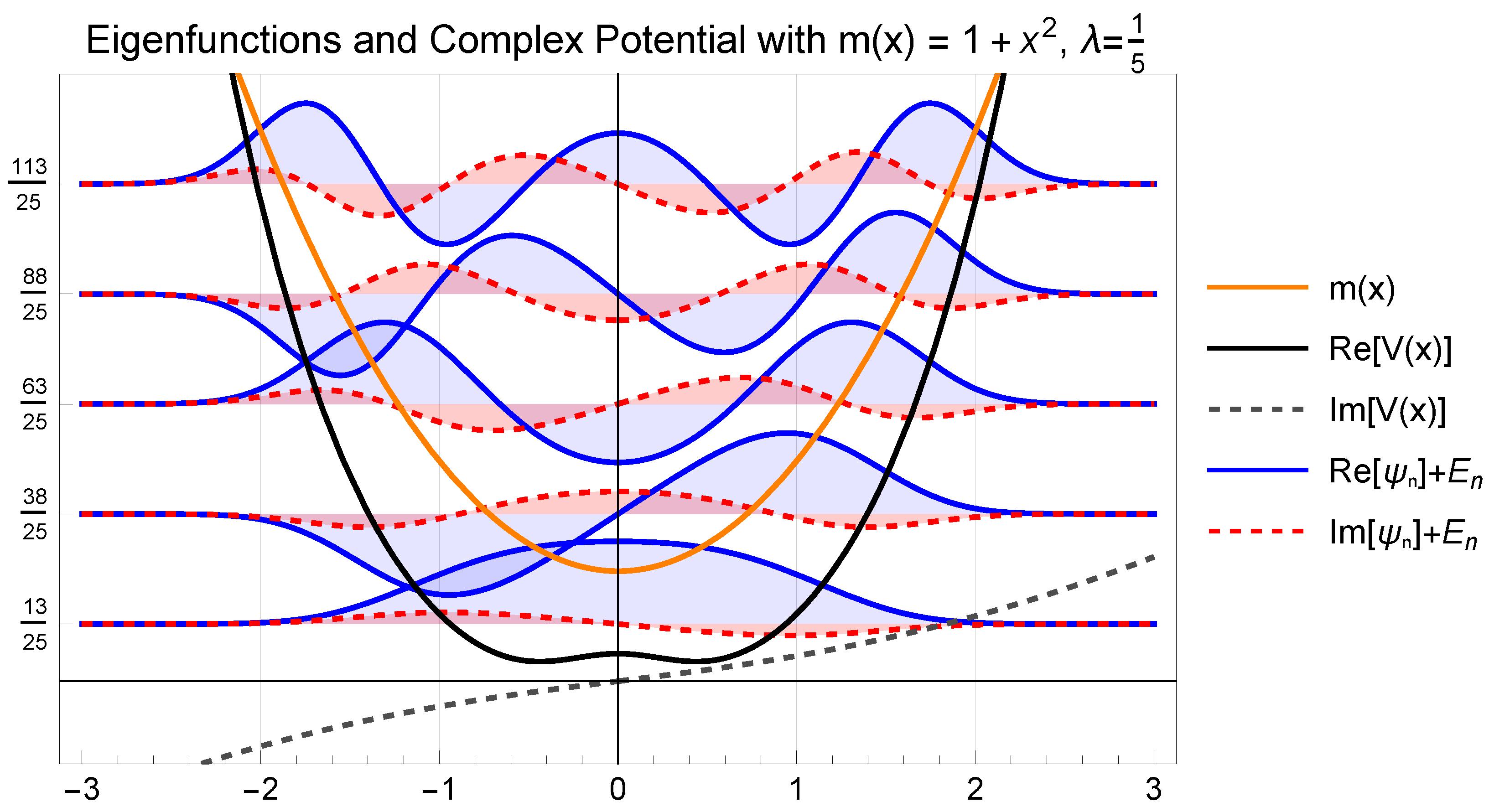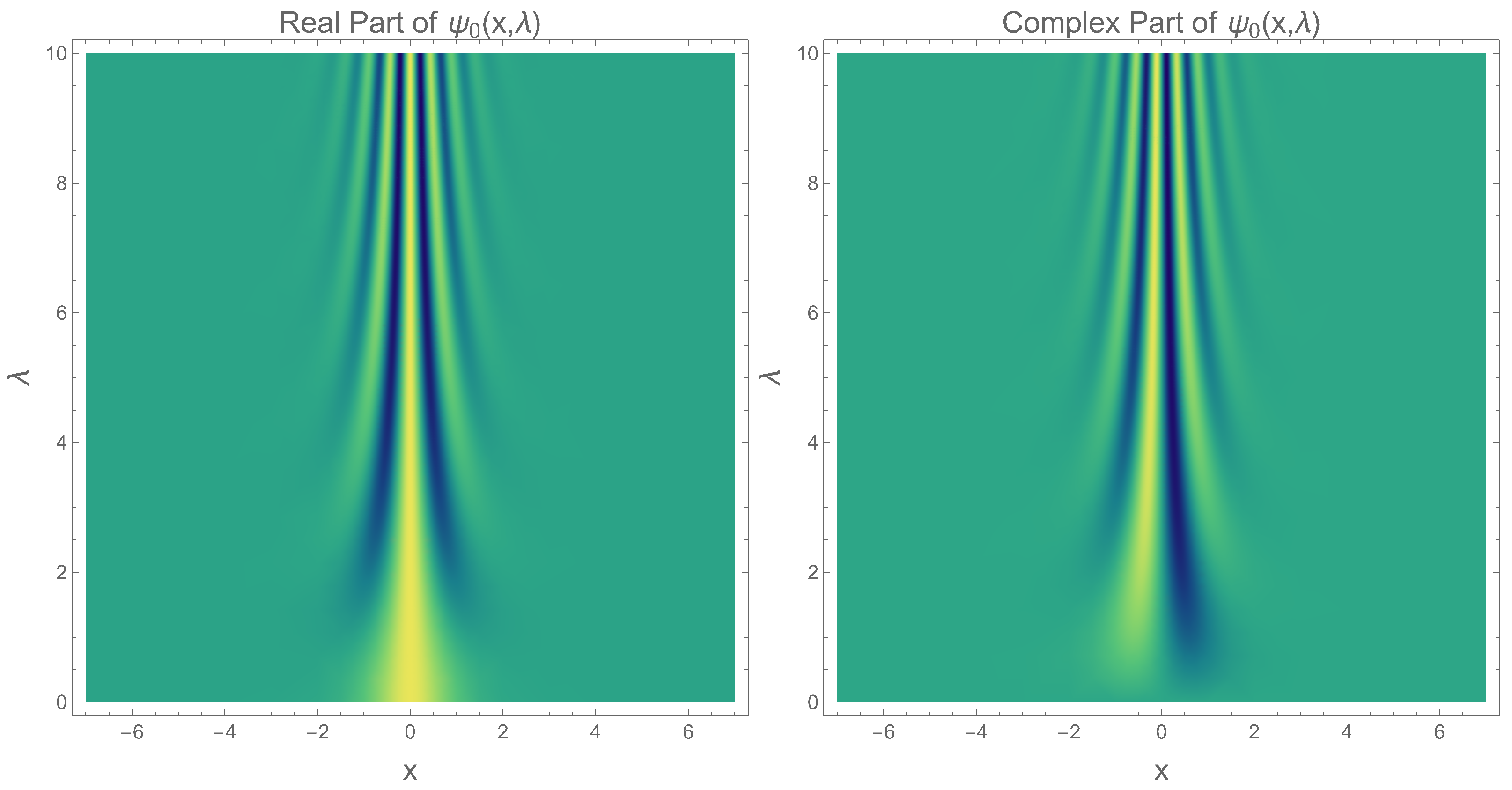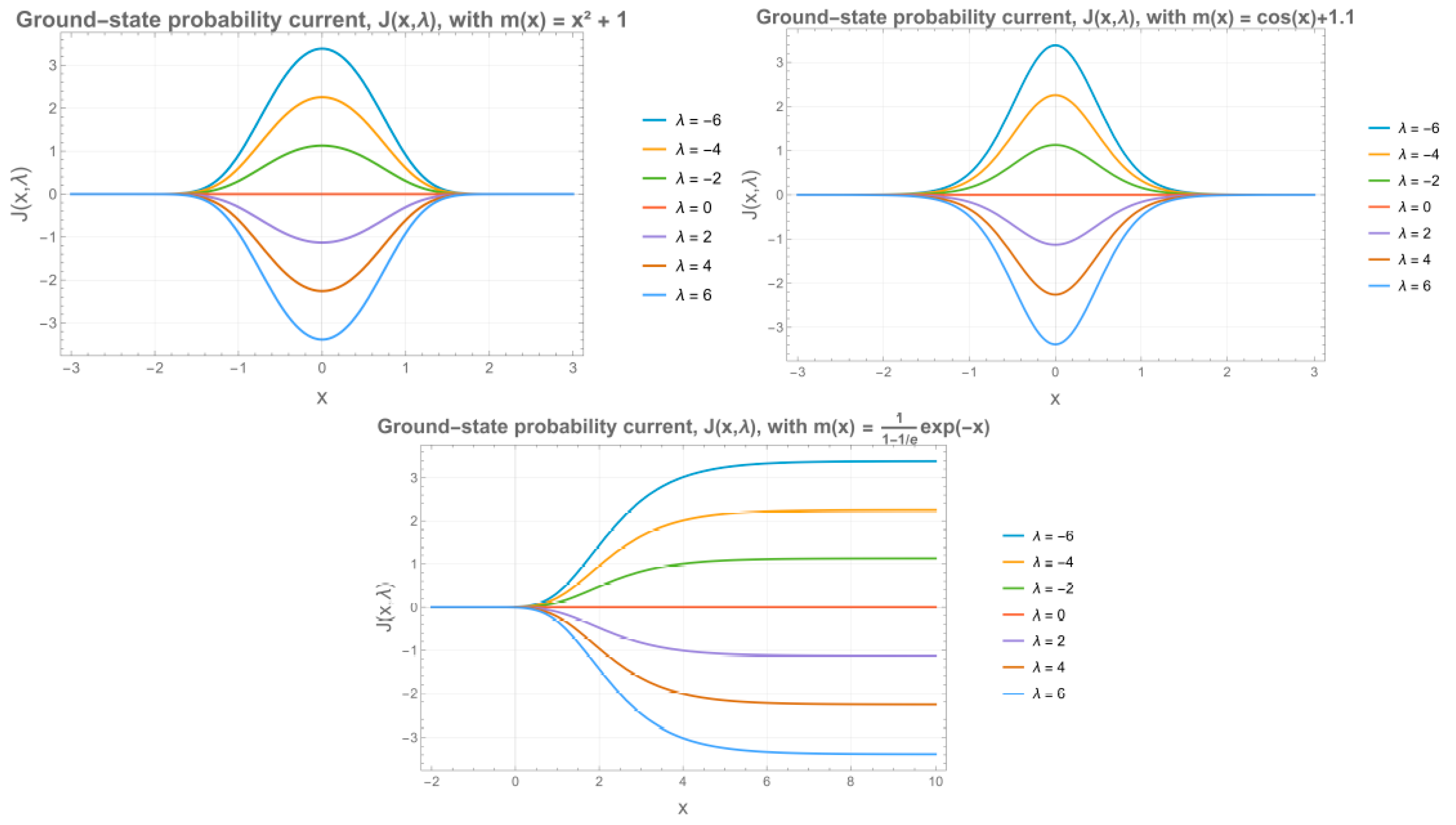1. Introduction
The study of position-dependent mass (PDM) systems has been extensive since 1966, when BenDaniel–Duke (BDD), investigating charge carrier behavior in semiconductor heterostructures, proposed a Hermitian Hamiltonian that incorporates the spatial variation of the electron’s effective mass across material interfaces [
1]. This variation is particularly relevant in systems such as the compositionally graded alloy
or in abrupt heterojunctions like
[
2,
3,
4]. These PDM models find applicability in the design of quantum dots, quantum wells, superlattices, and more general heterostructures [
4,
5,
6,
7,
8,
9]. In such systems, the effective mass profile
often reflects the underlying material composition and can, in principle, be engineered through epitaxial growth techniques and related methods [
10]. Interestingly, PDM systems also connect with the Liénard-II class of nonlinear equations, some of which admit isochronous oscillations and equidistant spectra [
11], highlighting the possibility of engineering non-linear systems with predictable energy spacings. Achieving arbitrary spatial profiles remains experimentally challenging. This limitation motivates an alternative theoretical question: given a fixed mass profile, regardless of its intricacy, what forms of the potential
allow the system to exhibit a desired energy spectrum? Addressing this inverse problem opens the door to spectral engineering within constrained material platforms. Traditional approaches fix the mass and potential profiles; for example, ref. [
12] explores a particular exponential mass with three different potentials. Other works use supersymmetric quantum mechanics to factorize the Hamiltonian via intertwining operators and corresponding superpartners [
13,
14,
15,
16,
17]. Alternative treatments rely on point canonical transformations that map the PDM to a position-independent mass (PIM) Schrödinger equation; once in the regime of PIM, standard exactly solvable techniques can be applied [
18,
19].
The determination of the spectral profile of PDM systems is a challenging problem in its own right. To date, non-Hermitian, position-dependent, and exactly solvable systems remain largely unexplored, with notable exceptions such as Mostafazadeh, who introduced
-pseudo-Hermiticity generators for such Hamiltonians [
20,
21,
22].
While the present work focuses on constructing complex ladder operators compatible with such configurations, future extensions could incorporate tools such as supersymmetric quantum mechanics to systematically manipulate the spectrum.
This paper is organized as follows:
Section 2 and
Section 3 provide a brief review of PDM Hamiltonians and the Heisenberg–Weyl algebra, respectively. In
Section 4, we construct a complex first-order ladder operator and the associated non-Hermitian Hamiltonian, present the factorization of
H and
, describe their commutation relations, and analyze the biorthogonality of the systems.
Section 5 presents illustrative applications involving three distinct mass profiles. In
Section 6, we numerically evaluate the expectation values of
for the ground and first excited states, as well as the probability current of the ground state. In
Section 7, we contrast the PT-symmetric, pseudo-Hermitian, and anti-pseudo-Hermitian cases with our construction. Finally,
Section 8 offers concluding remarks.
4. Complex First-Order Ladder Operators on the BDD Hamiltonian
The search for a general PDM system, specifically a BDD Hamiltonian possessing first-order ladder operators, was already initiated in [
17]. However, that work was restricted to Hermitian Hamiltonians and real ladder operators. In this paper, we aim to generalize this study to include non-Hermitian Hamiltonians and complex ladder operators, satisfying a Heisenberg–Weyl algebra. To this end, we begin with the aforementioned Hamiltonian:
Here,
is allowed to be a complex potential. We also need to construct a first-order differential operator,
following the same idea presented in [
17], but allowing for a complex
function such that
. This operator is meant to act as a complex ladder operator, specifically an annihilator operator
. For this to hold, a commutation relation, similar to the one presented in Equation (
4), must be satisfied:
After imposing this commutativity condition, the following equations arise:
We can solve Equation (
9) to find
as a function of the mass as follows:
From (
11), it is concluded that
, where
is an integration constant. Subsequently, the substitution of
as a function of
leads to a general expression for
as a function of the mass.
The previous equation greatly resembles the
function presented in [
17] when the ladder operator
was real.
Incorporating all of the above expressions, the potential is determined as
where the real and imaginary parts are given by
It is worth noting that the presence of a complex component in the ladder operator, introduced through a constant
, results in a nontrivial modification of the potential.
Looking for the ground state, at least a mathematical one, we should look for a function that is annihilated by
. Such an eigenfunction is given as follows:
Let us remark that the current Hamiltonian
H is not Hermitian; therefore, the operator
acts as a creation operator for
, but not, as desired, for
H. Thus, we need to begin the search for the corresponding creation operator.
We propose the existence of a creation operator
that is akin to the dagger of
but not exactly the same:
where
. With this proposition of
and after the imposition of the corresponding commutation relation
, we end up with the following creation operator:
It is worth noticing that the only difference with respect to the adjoint of is a sign in the complex part.
Since the creation operator has been constructed, we are now prepared to build the possible excited states by repeatedly applying
to the ground state; thus
The eigenvalues associated with these states, and possibly the physical energies once the boundary conditions are satisfied, are given as follows:
Finally, the commutator between the two ladder operators
and
can be readily calculated as
This commutation relation corresponds to the zero-degree polynomial Heisenberg algebra, where the commutator reduces to a constant.
4.1. Factorization
Since , the system is no longer Hermitian. This implies that orthogonality is no longer guaranteed.
Let us point out that the following commutation relation is satisfied:
after defining the adjoint ladder operators as
It follows straightforwardly that
is indeed the ladder operator of
:
At this point, we have two Hamiltonians with their respective ladder operators, and, as is expected, both can be factorized in terms of their respective ladder operators as follows:
The eigenstates of
are constructed analogously:
where
represents the eigenfunctions of
. After simplification, it is easy to verify that
and that both sets share the same real eigenvalues.
4.2. Biorthogonality
From the mathematical relations established above, it follows that
Hence, the inner product
must vanish for all
. Nevertheless, according to [
24,
25], the biorthogonal inner product—distinct from the conventional one—is defined as follows:
but, since we have already stated that
, we surprisingly recover a more familiar relation:
It is important to note that we are restricted to an arbitrary, but suitable, choice of a non-negative , with the requirement that this choice, together with appropriate boundary conditions, generates well-defined and normalizable eigenfunctions as described above.
6. Physical Interpretation of
The first appearance of
is as an unbounded, real integration constant, which arises when integrating Equation (
11). This parameter modulates the complex part of the ladder operators as well as the complex contribution to the potential. Moreover,
ultimately controls the phase and, consequently, the positions of the zeros of the real and imaginary parts of the eigenfunctions. Another notable effect is that the entire spectrum exhibits an upward shift proportional to
, while the spacing between adjacent levels remains unchanged.
The following discussion is based on numerical insights that give clues regarding the direct physical implications of . However, we were unable to derive exact formulas applicable to the entire spectrum; thus, we restricted our analysis to the ground and first excited states.
6.1. Expectation Values
We investigate the expectation values of , , and for the ground state, as well as the corresponding probability density. The expectation value of the position operator involves , so any phase contribution cancels out; hence, it is completely independent of .
The expectation value of the canonical momentum
is a different story. Since the operator involves a derivative with respect to position, a linear dependence on
naturally arises. One may ask whether an appropriate position-dependent mass, momentum, or pseudo-momentum operator could be defined. Some examples can be found in the literature [
26,
27]; however, these operators have been reported to be non-Hermitian or possess a predefined ordering. Additionally, they fail to reproduce the kinetic term of the BDD Hamiltonian, which is necessary for our analysis. Therefore, we restrict ourselves to a qualitative rather than quantitative analysis using the canonical momentum.
6.2. The Expectation Values of the Canonical Momentum
The expectation value of the canonical momentum for the eigenstate
is calculated as follows:
If we focus on the derivative of the ground state, it is evident that the derivative brings down one ; hence, we expect to follow a linear dependence on .
This integral was evaluated numerically for
and
. The aforementioned linear dependence is observed, the higher the
, the lower
(see
Figure 7).
For the first excited state, the expectation value
exhibits a non-linear dependence. This arises because
is obtained from
via the operator
, which introduces a factor of
. Consequently, the overall contribution is of order
: two powers come from
and its complex conjugate, and the third from the derivative (see
Figure 8).
6.3. The Expectation Values of the Kinetic Energy
The expectation value of the BDD kinetic operator is as follows:
Following the same reasoning as before, we expect to exhibit a quadratic dependence on , since the second derivative extracts two powers of from the phase.
Upon numerical integration over
, we find that
follows indeed a quadratic dependence on
(see
Figure 9).
Meanwhile,
exhibits a quartic dependence,
and its complex conjugate contribute with one lambda each; then, the second derivative will bring down two more (see
Figure 10).
6.4. The Probability Current
The probability current for the BDD Hamiltonian is well known and can be found in [
28]. It can be derived from the time-dependent Schrödinger equation and its complex conjugate by multiplying the first by
and the second by
, adding the two to eliminate the potential term, and grouping terms to identify
and
j. The resulting expression is as follows:
By using this equation, the probability currents associated with the ground states of each of the three problems were calculated:
For the three examples discussed, the probability currents are non-zero for
. Since these currents correspond to the flow of charge carriers, they are directly related to the electrical current: larger values of
lead to higher currents, and a positive
produces a current in the negative direction (see
Figure 11).
7. PT Symmetry, Pseudo-Hermiticity, and Related Properties
When dealing with non-Hermitian systems, one often encounters complex spectra or relies on PT symmetry or pseudo-Hermiticity to ensure real eigenvalues; see, for example, [
29,
30]. Interestingly, in our system, the spectrum remains entirely real despite the absence of an obvious PT-symmetric or pseudo-Hermitian structure.
7.1. PT Symmetry
PT symmetry is a property that requires a Hamiltonian
H to be invariant under parity–time transformations:
This relation alone is not sufficient to guarantee the reality of the spectrum. The eigenfunctions of
H must also be eigenfunctions of the
operator; otherwise, the PT symmetry is said to be broken, and some eigenvalues may become complex [
31,
32,
33].
The first step, therefore, is to check whether H is invariant under parity–time transformations, defined as and .
These definitions have some implications for the potential: the real part must be even, and the imaginary part odd. More importantly, when we examine the kinetic term of the BDD Hamiltonian, we find that PT symmetry requires . This is not a restriction in our mathematical framework, and we can easily choose a mass profile that does not satisfy this condition; therefore, our systems are not necessarily PT-symmetric.
7.2. Pseudo-Hermiticity and Anti-Pseudo-Hermiticity
PT-symmetric systems belong to a broader class of Hamiltonians, known as Pseudo-Hermitian. Pseudo-Hermiticity ensures the reality of the spectrum by imposing the following intertwining relation [
20,
21,
22,
34]:
which is equivalent to
This definition of Pseudo-Hermiticity requires
to be linear.
Let us take a look to our
H and
, both of which can be expressed as a kinetic plus a potential part:
The kinetic part is hermitian; meanwhile, the potential parts are related by the complex conjugation operation, which we denote
K. This complex conjugation operation has the property
, so that
and
.
Now, consider the following expression:
This shows that
. Next, let us see what happens with
:
Hence,
.
Finally, we can identify that
which is precisely Equation (
66).
We also need to remember that the complex conjugate operator is not linear, but an antilinear operator:
This allows us to conclude that our system belongs to the class of anti-pseudo-Hermitian operators [
22].
8. Discussion
Non-Hermitian, position-dependent mass Hamiltonians with complex ladder operators and real, equidistant spectra have been presented. A first-order differential operator satisfying the Heisenberg–Weyl algebra was constructed based on the BenDaniel–Duke Hamiltonian. To illustrate the method, three distinct mass profiles were examined: quadratic, cosinusoidal, and exponential. It was found that the parameter , which introduces a displacement in the energy spectrum and governs the imaginary part of the Hamiltonians, significantly affects the behavior of the eigenfunctions. In particular, as increases, the number of oscillations rises, and the positions of the nodes shift, even in the ground state. Notably, the ground state may exhibit oscillatory behavior solely due to variations in the parameter.
To quantify the impact of , we numerically calculated expectation values of the momentum and kinetic energy operators, as well as the corresponding probability currents. For the ground state, the momentum expectation value and probability currents exhibit a linear dependence on , while the ground-state kinetic energy shows an approximately quadratic dependence. For the first-excited state, displays a cubic dependence on , and exhibits a quartic dependence, illustrating how higher-order contributions emerge in excited states. These results demonstrate that the parameter systematically controls not only the eigenfunctions but also the dynamical observables of the system.
Since the Hamiltonians are non-Hermitian, the eigenstates are not orthogonal in the conventional sense. However, we demonstrate that the eigenstates of H and form a biorthogonal system and belong to the class of anti-pseudo-Hermitian systems. This structure preserves a generalized version of the superposition principle and supports a well-defined ladder operator formalism.
A natural extension of the present work could involve using supersymmetric quantum mechanics (SUSY QM) to generate new Hamiltonian systems that possess higher-order ladder operators. In this approach, an intertwining operator connects a known Hamiltonian to a new partner system through appropriate seed solutions, allowing for the construction of complex spectra with controlled features. Importantly, the parameter could continue to modulate both systems, while the resulting higher-order ladder operators may provide connections to analogs of nonlinear systems that naturally emerge within the SUSY formalism. This perspective opens a potential avenue for exploring richer non-Hermitian structures and spectral engineering possibilities.
Furthermore, complex potentials have optical analogs in photonic systems, where spatially varying complex refractive indices can simulate non-Hermitian Hamiltonians. As far as we know, direct analogs of position-dependent mass systems have not yet been explored, but it is conceivable that spatially varying effective masses could be implemented using engineered photonic lattices or waveguide arrays. Such optical realizations might provide a versatile platform for testing higher-order ladder operators and exploring spectral engineering possibilities that could emerge from SUSY-inspired constructions, representing an interesting avenue for future investigation.

















